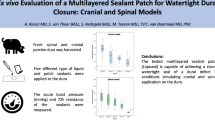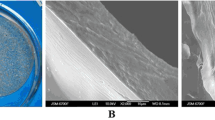Abstract
Purpose
Photosealing of many biological tissues can be achieved using a biocompatible material in combination with a dye that is activated by visible light to chemically bond over the tissue defect via protein cross-linking reactions. The aim of this study was to test the efficacy of photosealing using a commercially available biomembrane (AmnioExcel Plus) to securely close dural defects in comparison to another sutureless method (fibrin glue) in terms of repair strength.
Methods
Two-millimeter diameter holes were created in dura harvested from New Zealand white rabbits and repaired ex vivo using one of two methods: (1) in n = 10 samples, photosealing was used to bond a 6-mm-diameter AmnioExcel Plus patch over the dural defect, and (2) in n = 10 samples, fibrin glue was used to attach the same patch over the dural defect. Repaired dura samples were then subjected to burst pressure testing. Histological analysis was also performed of photosealed dura.
Results
The mean burst pressures of rabbit dura repaired with photosealing and fibrin glue were 302 ± 149 mmHg and 26 ± 24 mmHg, respectively. The increased repair strength using photosealing was statistically significant and considerably higher than the normal intracranial pressure of ~ 20 mmHg. Histology demonstrated a tight union at the interface between the dura surface and patch with no disruption of the dura structure.
Conclusion
The results of this study suggest that photosealing performs better than fibrin glue for the fixation of a patch for ex vivo repair of small dural defects. Photosealing is worthy of testing in pre-clinical models for the repair of dural defects.



Similar content being viewed by others
Data Availability
Data from the current original research are available from the corresponding author upon reasonable request.
References
Black P (2002) Cerebrospinal fluid leaks following spinal surgery: use of fat grafts for prevention and repair. Technical note J Neurosurg 96(2 Suppl):250–252. https://doi.org/10.3171/spi.2002.96.2.0250
Bono F, Giliberto C, Lavano A, Quattrone A (2005) Posture-related cough headache and orthostatic drop in lumbar CSF pressure. J Neurol 252:237–238
Brodie HA (1997) Prophylactic antibiotics for posttraumatic cerebrospinal fluid fistulae. A meta-analysis. Arch Otolaryngol Head Neck Surg 123(7):749–52. https://doi.org/10.1001/archotol.1997.01900070093016
Chan BP, Chan OC, So KF (2008) Effects of photochemical crosslinking on the microstructure of collagen and a feasibility study on controlled protein release. Acta Biomater 4(6):1627–1636. https://doi.org/10.1016/j.actbio.2008.06.007
Choi EH, Chan AY, Brown NJ, Lien BV, Sahyouni R, Chan AK, Roufail J, Oh MY (2021) Effectiveness of repair techniques for spinal dural tears: a systematic review. World Neurosurg 149:140–147. https://doi.org/10.1016/j.wneu.2021.02.079
Ding B, Wang X, Yao M (2019) Photochemical tissue bonding technique for improving healing of hand tendon injury. Surg Innov 26(2):153–161. https://doi.org/10.1177/1553350618824448
Fairbairn NG, Ng-Glazier J, Meppelink AM et al (2016) Light-activated sealing of acellular nerve allografts following nerve gap injury. J Reconstr Microsurg 32(6):421–430. https://doi.org/10.1055/s-0035-1571247
Fengbin Yu, Feng Wu, Zhou R, Guo L, Zhang J, Tao D (2013) Current developments in dural repair: a focused review on new methods and materials. Front Biosci (Landmark Ed) 18(4):1335–1343. https://doi.org/10.2741/4182
Forer B, Vasilyev T, Brosh T et al (2005) Repair of pig dura in vivo using temperature controlled CO2 laser soldering. Lasers Surg Med 37(4):286–292. https://doi.org/10.1002/lsm.20230
Haines DE, Harkey HL, al-Mefty O (1993) The “subdural” space: a new look at an outdated concept. Neurosurgery 32(1):111–20. https://doi.org/10.1227/00006123-199301000-00017
Hale AT, Gannon SR, Zhao S, Dewan MC, Bhatia R, Bezzerides M, Stanton AN, Naftel RP, Shannon CN, Pruthi S, Wellons JC (2019) Graft dural closure is associated with a reduction in CSF leak and hydrocephalus in pediatric patients undergoing posterior fossa brain tumor resection. J Neurosurg Pediatr 29:1–7. https://doi.org/10.3171/2019.9.PEDS1939
Johnson TS, O’Neill AC, Motarjem PM et al (2007) Photochemical tissue bonding: a promising technique for peripheral nerve repair. J Surg Res 143(2):224–229. https://doi.org/10.1016/j.jss.2007.01.028
Kamegaya Y, Farinelli WA, Vila Echague AV et al (2005) Evaluation of photochemical tissue bonding for closure of skin incisions and excisions. Lasers Surg Med 37(4):264–270. https://doi.org/10.1002/lsm.20221
Kaufman BA, Tunkel AR, Pryor JC, Dacey RG Jr (1990) Meningitis in the neurosurgical patient. Infect Dis Clin North Am 4(4):677–701
Kinaci A, Algra A, Heuts S, O’Donnell D, van der Zwan A, van Doormaal T (2018) Effectiveness of dural sealants in prevention of cerebrospinal fluid leakage after craniotomy: a systematic review. World Neurosurg 118:368-376.e1. https://doi.org/10.1016/j.wneu.2018.06.196
Kinaci A, Bergmann W, Bleys RL, van der Zwan A, van Doormaal TP (2020) Histologic comparison of the dura mater among species. Comp Med 70(2):170–175. https://doi.org/10.30802/AALAS-CM-19-000022
Kinaci A, Moayeri N, van der Zwan A, van Doormaal TPC (2019) Effectiveness of sealants in prevention of cerebrospinal fluid leakage after spine surgery: a systematic review. World Neurosurg 127:567-575.e1. https://doi.org/10.1016/j.wneu.2019.02.236
Kothe R, Quante M, Engler N, Heider F, Kneißl J, Pirchner S, Siepe C (2017) The effect of incidental dural lesions on outcome after decompression surgery for lumbar spinal stenosis: results of a multi-center study with 800 patients. Eur Spine J 26(10):2504–2511. https://doi.org/10.1007/s00586-016-4571-8
Martínez-Lage JF, Pérez-Espejo MA, Palazón J et al (2006) Autologous tissues for dural grafting in children: a report of 56 cases. Childs Nerv Syst 22:139–144. https://doi.org/10.1007/s00381-005-1232-3
Mulroy L, Kim J, Wu I, Scharper P, Melki SA, Azar DT, Redmond RW, Kochevar IE (2000) Photochemical keratodesmos for repair of lamellar corneal incisions. Invest Ophthalmol Vis Sci 41(11):3335–3340
Narotam PK, van Dellen JR, Bhoola KD (1995) A clinicopathological study of collagen sponge as a dural graft in neurosurgery. J Neurosurg 82(3):406–412. https://doi.org/10.3171/jns.1995.82.3.0406
O’Neill AC, Winograd JM, Zeballos JL, Johnson TS, Randolph MA, Bujold KE, Kochevar IE, Redmond RW (2007) Microvascular anastomosis using a photochemical tissue bonding technique. Lasers Surg Med 39(9):716–722. https://doi.org/10.1002/lsm.20548
Ozcelikkale A, Han B (2016) Thermal destabilization of collagen matrix hierarchical structure by freeze/thaw. PLoS One 11(1):e0146660. Published 2016 Jan 14. https://doi.org/10.1371/journal.pone.0146660
Pattichis AA, Slee M (2016) CSF hypotension: a review of its manifestations, investigation and management. J Clin Neurosci 34:39–43. https://doi.org/10.1016/j.jocn.2016.07.002
Schmalz P, Griessenauer C, Ogilvy CS, Thomas AJ (2018) Use of an absorbable synthetic polymer dural substitute for repair of dural defects: a technical note. Cureus 10(1):e2127. https://doi.org/10.7759/cureus.2127
Scott BB, Wang Y, Wu RC, Randolph MA, Redmond RW (2021) Light-activated photosealing with human amniotic membrane strengthens bowel anastomosis in a hypotensive, trauma-relevant swine model. Lasers Surg Med 54(3):407–417. https://doi.org/10.1002/lsm.23485
Soni AJ, Modi G (2020) Outcome of uncorrected CSF leak and consequent recurrent meningitis in a patient: a case presentation and literature review. Br J Neurosurg 34(5):492–494. https://doi.org/10.1080/02688697.2018.1478063
Standard test method for burst strength of surgical sealants. https://www.astm.org/f2392-04r15.html. Accessed Jan 20 2023
van Doormaal T, Kinaci A, van Thoor S, Redegeld S, Bergmann W, van der Zwan A (2018) Usefulness of sealants for dural closure: evaluation in an in vitro model. Oper Neurosurg (Hagerstown, MD) 15(4):425–432. https://doi.org/10.1093/ons/opx260
Acknowledgements
The authors wish to thank Dr. Michael Marshall, MD, Ph.D., for his assistance in interpreting histology samples.
Author information
Authors and Affiliations
Corresponding author
Ethics declarations
Conflict of interest
The authors declare no competing interests.
Additional information
Publisher's note
Springer Nature remains neutral with regard to jurisdictional claims in published maps and institutional affiliations.
Supplementary information
Below is the link to the electronic supplementary material.
Rights and permissions
Springer Nature or its licensor (e.g. a society or other partner) holds exclusive rights to this article under a publishing agreement with the author(s) or other rightsholder(s); author self-archiving of the accepted manuscript version of this article is solely governed by the terms of such publishing agreement and applicable law.
About this article
Cite this article
King, N.C., Guastaldi, F.P.S., Khanna, A.R. et al. Photosealing of dural defects using a biocompatible patch. Acta Neurochir 165, 2293–2298 (2023). https://doi.org/10.1007/s00701-023-05653-z
Received:
Accepted:
Published:
Issue Date:
DOI: https://doi.org/10.1007/s00701-023-05653-z




